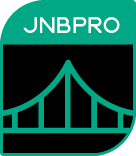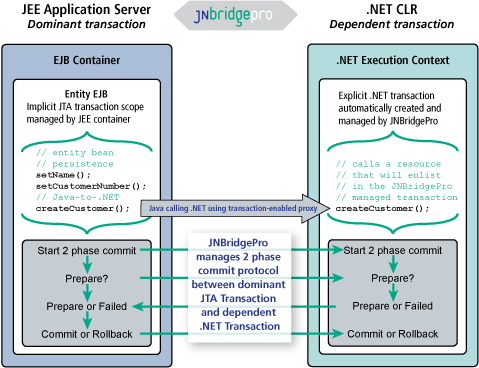Transaction:
A sequence of information that is treated as an individual unit and follows the “ACID” (atomicity, consistency, isolation and durability) test. A transaction must succeed or fail as a unit, following the atomic rule of “all or nothing.” A transaction must be consistent, leaving both sides in a valid state. A transaction is isolated, unaware of or not seen by other concurrently executing transactions. And a transaction must be durable: once it succeeds it must persist.
Feature
Support for cross-platform transactions that seamlessly extend container-managed Java transactions to .NET or .NET transaction scopes to Java.
Benefit
Enable cross-platform transactions quickly and easily, with near-negligible amounts of development time and effort.
.NET-to-Java and Java-to-.NET Cross-platform Transactions with 2-Phase Commit
Electronic transactions are the heart of our commercial world. Economic systems require a significant amount of confidence and trust between customers, shopkeepers, businesses, banks, governments and national economies. Transaction processing insures that trust by maintaining the integrity and consistency of financial data. In the data center, support for global transaction processing is provided by IT systems that use implementations that conform to accepted standards. However, transactions are not truly global as different IT frameworks implement standards differently, leading to incompatible transactions.
The incompatibilities between Enterprise Java and Microsoft transactions and transaction managers has been a barrier to integration between the business entities involved in electronic commerce. There have been industry-driven interoperability solutions like TIP (Transaction Internet Protocol) and WS-AT (Web Services Atomic Transaction). TIP is now obsolete. WS-AT requires a significant investment in additional implementation, configuration, training and other costs in order to expose the cross-platform transactions as Web services. Moreover, WS-AT also requires investment in Enterprise Java Transaction Managers that implement an additional web service protocol, WS-Coor (Web Services Coordination), to allow interoperability with Microsoft Distributed Transaction Coordinators.
JNBridgePro-enabled transaction architecture in the Java-calling-.NET direction. The .NET-calling-Java direction is similar.
JNBridge provides an alternative to WS-AT that integrates Enterprise Java and .NET distributed transactions by making them truly cross-platform. JNBridgePro, the Java and .NET interoperability tool, has always been an integration alternative to Web services that allows Java to create and call anything in .NET and .NET to create and call anything in Java. Starting with version 5.0, JNBridgePro now supports cross-platform transactions that seamlessly extend container-managed Java transactions to .NET or .NET transaction scopes to Java. This eliminates the overhead that’s associated with loosely coupled SOAP messages implementing web services, WSAT and WS-Coor between platforms, the Java EE (Java Enterprise Edition) transaction manager and MSDTC (Microsoft’s Distributed Transaction Coordinator).
In the Java-to-.NET direction, JNBridgePro supports cross-platform transactions by extending an existing implicit transaction on the Java EE side to a managed explicit transaction on the .NET side. JNBridgePro automatically creates and manages a .NET “CommittableTransaction.” The CommittableTransaction is associated with the thread in which Java-to-.NET calls execute on the .NET side. This transaction is dependent on the dominant Java-side transaction that’s calling it, and it participates in the two-phase commit protocol that’s managed by the Java EE transaction manager or monitor. JNBridgePro provides a similar mechanism for .NET-to-Java calls that map the dominant .NET transaction scope to a dependent Java EE “UserTransaction.”
For example, say you needed to integrate a .NET-based customer billing system into a Java-based CRM system. A simple architecture would be an Entity EJB (Enterprise Java Bean) that executes in a Java EE container. The Java EE container manages the implicit transaction context in which the EJB executes. In this example, the Entity Bean provides the persistence mechanism for the customer data, and we’d need to integrate the .NET-based customer billing application into the Entity Bean. Using JNBridgePro, we can create transaction-enabled Java proxies of the billing application’s API. The Entity Bean can then create and update customer data on both the Java-based CRM system and the .NET-based billing application. Data integrity is ensured on the Java side by the Java EE container-managed transaction. Data integrity is ensured on the .NET side by a JNBridgePro-managed .NET transaction. If either side throws an exception during data processing, both transactions are rolled back. If no exception occurs and the two-phase commit protocol begins, then if during the prepare phase either the Java Transaction Manager or the MSDTC force a rollback, both transactions are rolled back.
Using JNBridgePro to enable cross-platform transactions costs a negligible amount of development time and effort—almost zero—when compared to the work entailed in implementing actions via Web services plus the investment in setting up and configuring WS-AT and WS-Coor enabled transaction managers on both sides.


